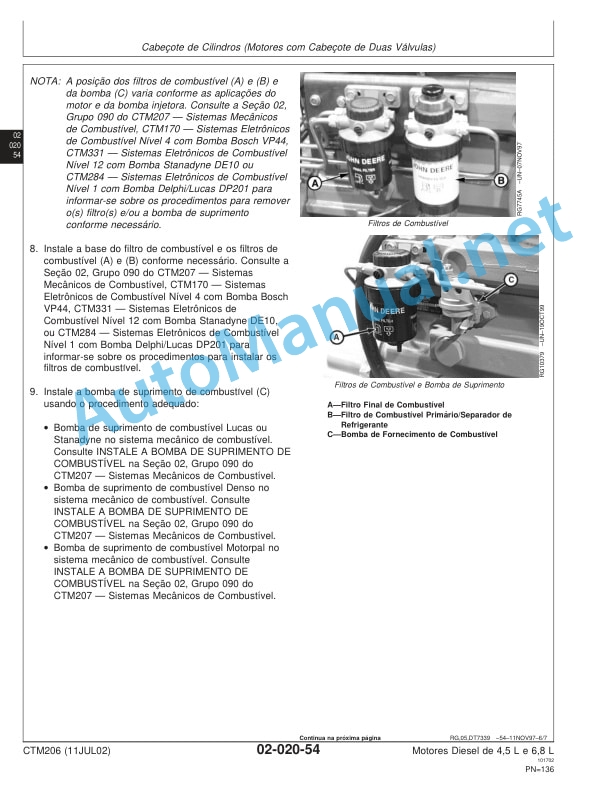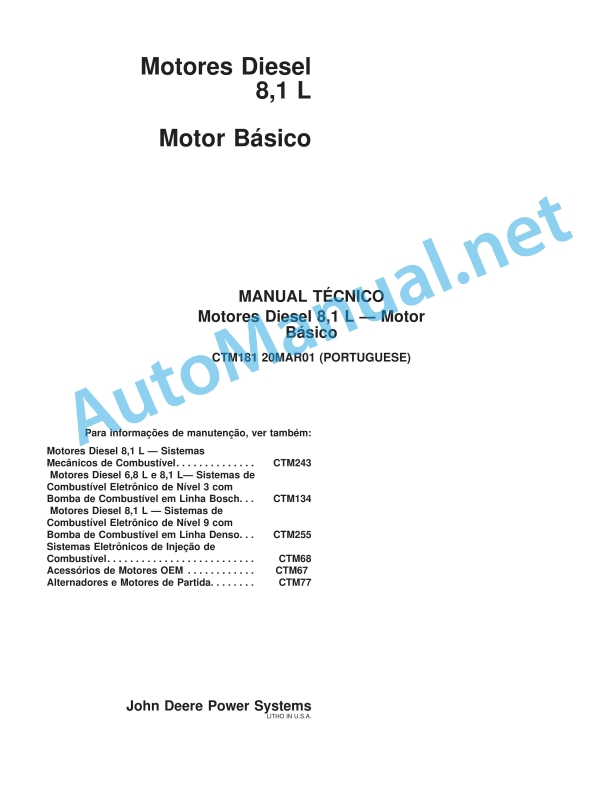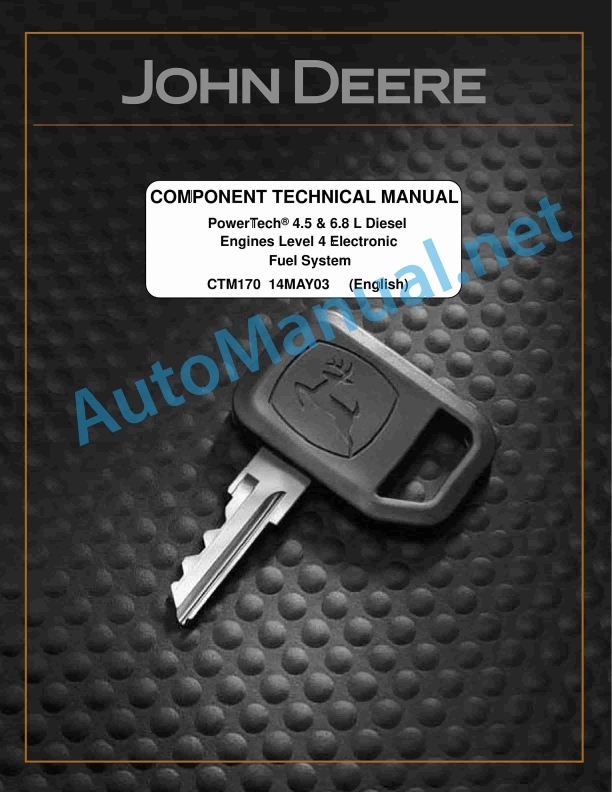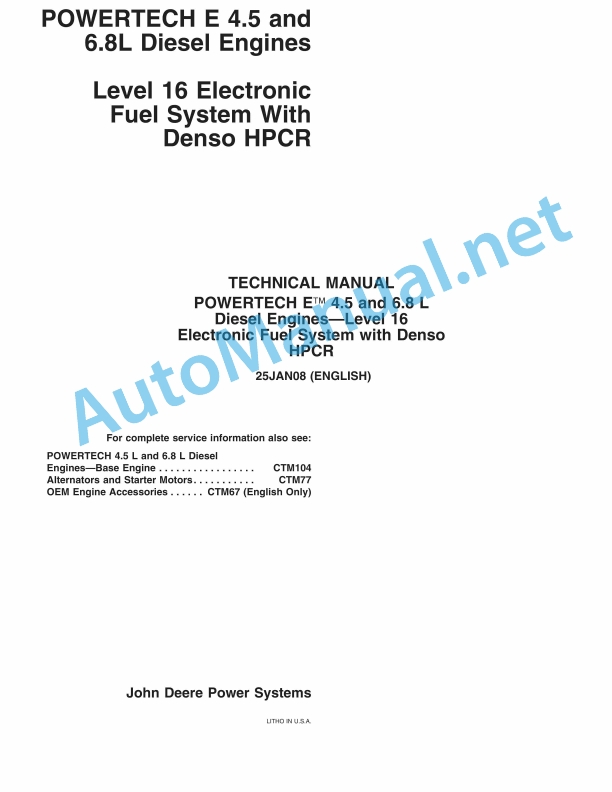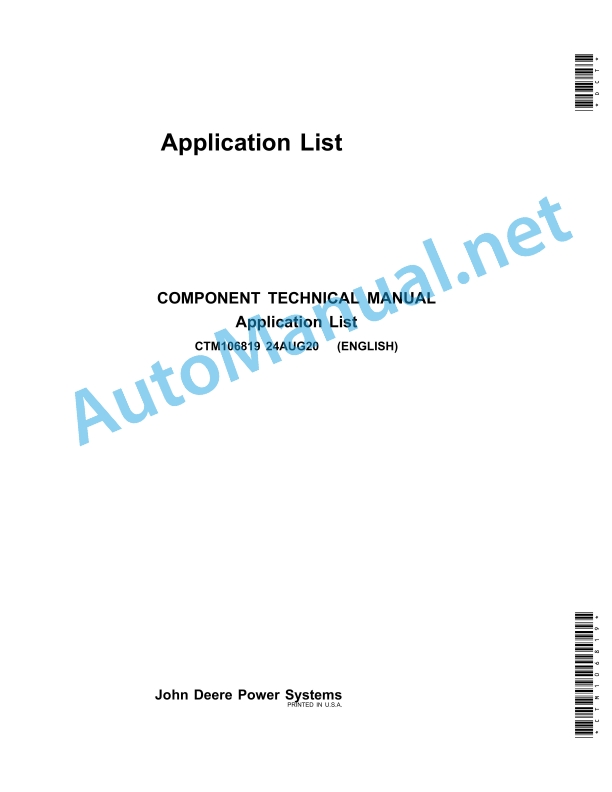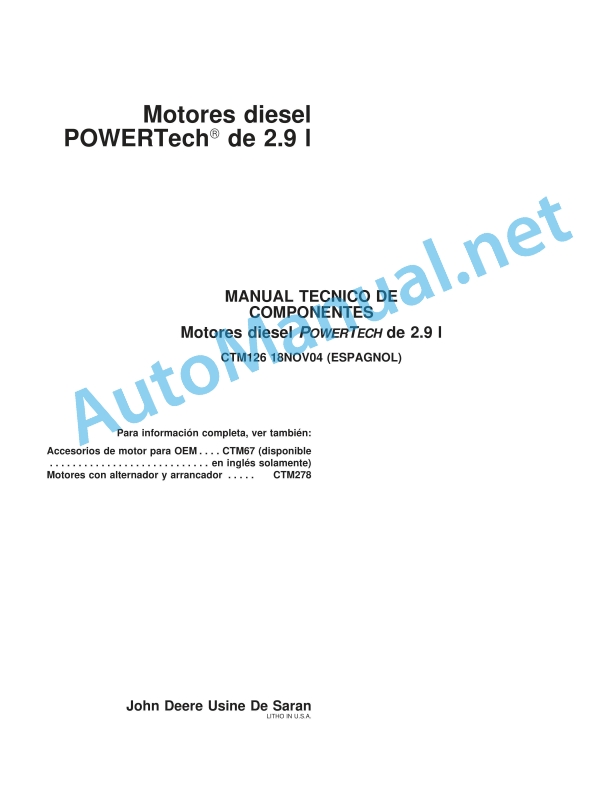Claas Dominator 130 (456) Combines Operator Manual FR
$50.00
- Model: Dominator 130 (456) Combines
- Type Of Manual: Operator Manual
- Language: FR
- Format: PDF(s)
- Size: 65.1 MB
File List:
00 0300 694 3.pdf
00 0300 694 3.pdf:
DOMINATOR 130
Contents
1 Introduction
1.1 General information
1.1.1 Validity of the notice
1.1.2 Information regarding this user manual
1.1.3 Icons and notes
1.1.4 Optional equipment
1.1.5 Qualified specialist workshop
1.1.6 Notes on maintenance
1.1.7 Notes regarding warranty
1.1.8 Spare parts and technical questions
1.2 Use in accordance with instructions
1.2.1 Use in accordance with the provisions
1.2.2 Reasonably foreseeable misuse
2 Security
2.1 Recognize the warnings
2.1.1 Warning pictogram
2.1.2 Signal word
2.2 Safety tips
2.2.1 Meaning of the instructions for use
2.2.2 Observe warning pictograms and warnings
2.2.3 Observe warning pictograms and warnings
2.2.4 Requirements for all people who work with the machine
2.2.5 Children at risk
2.2.6 Risk areas
2.2.7 Do not stand between the machine and the front tool
2.2.8 Guide passenger during work
2.2.9 Couple the machine with a front implement or trailer
2.2.10 Risk of injury due to rotating shafts
2.2.11 Constructive modifications
2.2.12 Optional equipment and spare parts
2.2.13 Checking the running machine
2.2.14 Operation only after commissioning checks
2.2.15 Technical condition
2.2.16 Danger in the event of damage to the machine
2.2.17 Respect technical threshold values
2.2.18 Danger due to inertia of machine elements
2.2.19 Maintain safety devices in operational capacity
2.2.20 Wear suitable clothing
2.2.21 Remove dirt and loose objects
2.2.22 Prepare the machine for road travel
2.2.23 Risks when traveling on the road and in the field
2.2.24 Park the machine correctly
2.2.25 Unsuitable operating consumables
2.2.26 Safe handling of operating consumables and secondary operating consumables
2.2.27 Fuel is harmful to health
2.2.28 Refrigerants are harmful to health
2.2.29 Environmental protection and disposal
2.2.30 There must be no chemicals in the cabin
2.2.31 Fire risks
2.2.32 Fatal electric shock from overhead power lines
2.2.33 Behavior in the event of voltage discharge from overhead power lines and lightning strikes
2.2.34 Electrical discharge from the electrical system
2.2.35 Noise can cause health problems
2.2.36 Vibrations can be harmful to health
2.2.37 Compressed air
2.2.38 Toxic exhaust gases
2.2.39 Hot surfaces
2.2.40 Safety when getting on and off
2.2.41 Only carry out work on the machine when it is stopped
2.2.42 Maintenance and repair work
2.2.43 Machine elements recorded and loads
2.2.44 Welding work is prohibited
2.2.45 Risks due to welding work
2.2.46 Checking and charging the battery
2.3 Safety label
2.3.1 Structure of warning pictograms
2.3.2 Engine warning pictograms
2.3.3 Undercarriage warning pictograms
2.3.4 Hydraulic system warning pictograms
2.3.5 Cabin/driving station warning pictogram
2.3.6 Power group warning pictograms
2.3.7 Threshing gear warning pictograms
2.3.8 Separation warning pictograms
2.3.9 Cleaning warning pictograms
2.3.10 Warning pictograms for harvest/straw storage
2.3.11 Grain recovery warning pictograms
2.3.12 Warning pictograms of assembly parts / machine housing
3 Description of the machine
3.1 Overview and mode of operation
3.1.1 DOMINATOR 130 front and left side overview
3.1.2 Overview of the machine from the rear and right side
3.1.3 Operating mode of the machine
3.1.4 Diesel engine overview
3.1.5 Overview of cooling units
3.2 Nameplates and vehicle identification number
3.2.1 Rating plate on the diesel engine
3.2.2 Machine nameplate
Rating plate according to ECE-R 120
3.2.3 Rating plate, drive axle
3.2.4 Nameplate, steering axle
3.2.5 Hitch clevis nameplate
3.2.6 Cabin nameplate
4 Controls and displays
4.1 Cabin and driving position
4.1.1 Driving position
4.1.2 Hydraulic distributor
4.1.3 Control console
4.1.4 Function of warning lights on the control console
4.1.5 Lever for adjusting the speed of the diesel engine
4.1.6 Switch lever
4.1.7 Steering column control elements
4.1.8 Display of the position of the steering wheels*
4.1.9 Ignition lock
4.1.10 Function monitoring device*
4.1.11 Overview of the driving informant
4.1.12 Adjusting elements, cabin roof
4.1.13 Driver’s seat
5 Technical characteristics
5.1 DOMINATOR 130 – Type 456
5.1.1 Perkins 1106D-70TA diesel engine
5.1.2 Perkins 1106C-70TA diesel engine
Perkins 1106C-70TA diesel engine
Properties
5.1.3 Undercarriage
Forward speed
Measurement conditions
Properties
5.1.4 Tire pressure
5.1.5 Overview of drive axle tracks
5.1.6 Overview of the steering axle tracks
5.1.7 Channel table 1
5.1.8 Channel table 2
5.1.9 Channel table 3
5.1.10 Channel table 4
5.1.11 Turning radius diameter
5.1.12 Brakes
5.1.13 Management
5.1.14 Electrical and electronic system
5.1.15 Noise level and vibrations
5.1.16 Power group
5.1.17 Threshing bodies
5.1.18 Separation
5.1.19 Cleaning
5.1.20 Hopper volume
5.1.21 Dimensions of the hopper drain tube in working position
5.1.22 Machine dimensions
5.1.23 Weight
5.2 Operating consumables
5.2.1 Lubricants
5.2.2 Coolant
5.2.3 Hydraulic oils
5.2.4 Brake fluid
5.2.5 Select the permitted fuel
6 Preparing the machine
6.1 Stop and immobilize the machine
6.1.1 Disconnect the machine and secure it
6.1.2 Block the machine to avoid any risk of movement
6.2 Access workstations and maintenance stations
6.2.1 Pivot the front ladder
6.2.2 Adjust the rear scale
6.2.3 Access to the workstation and maintenance locations
6.3 Adjusting the machine for work
6.3.1 Set the machine to harvest grain
6.3.2 Set the machine to harvest corn
6.3.3 Set the machine to harvest rice
6.3.4 Set the machine from rice harvest to grain harvest
6.3.5 Grid table
6.3.6 Threshing table
6.3.7 Clean the machine for harvesting the seed
6.4 Loading the machine
6.4.1 Loading and securing the machine
6.4.2 Remove the crane eyes
6.5 Front tool
6.5.1 Install the front tool
6.5.2 Align the receiving tenons
6.5.3 Install the support plates
6.5.4 Install and remove the cardan shaft
6.5.5 Connect the hydraulic hoses
6.5.6 Connect the electrical cables*
6.5.7 Remove the front tool
6.6 Diesel engine
6.6.1 Select authorized fuels
6.6.2 Comply with the fuel specification
6.6.3 Comply with fuel specifications
6.6.4 Using winter fuel at low temperatures
6.6.5 Refuel
6.6.6 Install the radiator screen
6.7 Chassis
6.7.1 Remove and install the wheels
6.7.2 Place the machine on jack stands
Place the machine on a jack stand under the axles
Place the machine on jack stands at the rear under the chassis
6.7.3 Overview of the steering axle
6.7.4 Adapting the steering axle from transport position to working position
6.7.5 Steering axle 00 0694 220 X – adjust track
Check the mobility of the steering axle
6.8 Brake
6.8.1 Check the parking brake
6.8.2 Check the foot brake
6.9 Coupling device
6.9.1 Install the hitch clevis*
6.9.2 Hitching the trailer
6.9.3 Unhitching the trailer
6.10 Hydraulics
6.10.1 Identify hydraulic oil
6.11 Electrical and electronic system
6.11.1 Install the air conditioning compressor fuse
6.11.2 Adjust the cutting height display
6.12 Cabin and driving position
6.12.1 Install the mirror
6.13 Power group
6.13.1 Adjusting the front implement relief springs
6.13.2 Install and remove the locking elements on the front tool cylinder
6.13.3 Adjust the scraper profiles
6.13.4 Adjust the height of the feed chain
6.14 Threshing bodies
6.14.1 Opening and closing the destoner container
6.14.2 Remove and install the destoner tray cover*
6.14.3 Opening and closing the mixer hatch
6.14.4 Remove and install the concave segments (MULTICROP concave)
6.14.5 Adjusting the concave basic setting
6.14.6 Install and remove the mixer cover plates*
6.14.7 Install and remove the grid* or sheet metal* of the concave
6.14.8 Install the final concave bat*
6.14.9 Remove or install the trimming bats*
6.14.10 Install the anti-winding device* in the beater cage
6.15 Separation
6.15.1 Remove and install the anti-splash fabric
6.15.2 Remove and install the side separators
6.15.3 Install and remove the CCM separators
6.15.4 Remove and install the central separators
6.15.5 Remove and install the rice separators
6.15.6 Install and remove the shaker cover plate*
6.15.7 Adjust the separation flow control* sensors
6.16 Cleaning
6.16.1 Remove the grids
6.16.2 Install the grids
6.16.3 Place the spacers on the grids
6.16.4 Cover and open the return of potatoes
6.16.5 Setting the fan speed display
6.16.6 Adjust the cleaning flow control sensors*
6.17 Grain recovery
6.17.1 Getting into the hopper and leaving the hopper
Getting in and out of the shaker area
6.17.2 Install and remove the hopper protection device
6.17.3 Adjust the hopper auger cover plates
6.17.4 Close the discharge hatch at the hopper drain tube
6.18 Deposit of harvested product and deposit of straw
6.18.1 Adjust the speed of the straw chopper
6.18.2 Pivot the straw guide plate downwards and remove it
6.18.3 Place the straw guide plate and pivot it downwards
6.18.4 Install the rubber canvas* of the straw chopper
Install the rubber canvas
6.18.5 Remove the rubber cloth* from the straw chopper
Remove the rubber canvas
6.18.6 Place and place the cover plate* on the counter-knives of the straw chopper
Install the cover plate
Remove the cover plate
6.18.7 Bring the straw chopper to the grid assembly position
6.18.8 Hang the straw guide apron at a height
6.19 Assembly parts and bodywork
6.19.1 Ballast the machine with weights
Fill the weight in the tires of the steering axle
Select the weighting mass
6.19.2 Checking the reverse warning
7.1 Driving the machine
7.1.1 Prepare for road travel
7.1.2 Prepare to move into the field
7.1.3 Operating the machine
Moving the machine forward and backward
7.1.4 Park the machine
7.1.5 Maneuver the machine
7.1.6 Tow the machine out of the risk area
7.2 Front tool
7.2.1 Adjust the reel horizontally (mechanically)
7.2.2 Adjust the reel horizontally (hydraulically)*
7.2.3 Raise or lower the reel
7.2.4 Electrically adjust* the peripheral speed of the reel
7.2.5 Mechanically adjust the reel peripheral speed
7.3 Diesel engine
7.3.1 Connect the diesel engine
If the outside temperature is below 0°C, allow the diesel engine to warm up.
If the outside temperature is below -10°C, allow the diesel engine and hydraulic system to warm up.
7.3.2 Discoe the diesel engine
7.3.3 Adjusting the diesel engine speed
7.4 Chassis
7.4.1 Submit a report
7.5 Brake
7.5.1 Braking the machine with the foot brake pedal
7.5.2 Apply the parking brake
7.5.3 Release the parking brake
7.6 Management
7.6.1 Pay attention to driving behavior
7.6.2 Adjusting the steering column
7.7 Cabin and driving position
7.7.1 Fan with heating* and air conditioning*
7.8 Power group
7.8.1 Connect and disconnect the power group
7.8.2 Reverse the front tool
7.8.3 Raise or lower the power unit and front tool
7.8.4 Read the cutting height
7.8.5 Read the ground support pressure
7.9 Threshing bodies
7.9.1 Connecting and disconnecting the beaters
7.9.2 Change concave setting
7.9.3 Clear jam
7.9.4 Adjust the mixer speed
7.9.5 Adjust the mixer speed
7.9.6 Check the return of the oats
7.10 Separation
7.10.1 Adjust the anti-splash fabric
7.10.2 Adjust the anti-splash fabric
7.10.3 Observe the straw jam warning behind the separation
7.10.4 Set separation flow control display
7.11 Cleaning
7.11.1 Adjusting the grate openings
Adjust the upper rack
Adjust the bottom rack
7.11.2 Adjust the fan speed
7.11.3 Adjust the ventilation hatch
7.11.4 Set the cleaning flow rate* control display
7.12 Deposit of harvested product and deposit of straw
7.12.1 Commissioning the straw chopper (swivel the deflector plate spreader to the chopping position)
7.12.2 Put the straw chopper out of service (swivel the deflector plate spreader to the windrowing position)
7.12.3 Deactivate function control*
7.12.4 Pivot the deflector plate spreader
Pivot the deflector plate spreader
7.12.5 Adjust the counter-knife (standard straw chopper)
7.13 Grain recovery
7.13.1 Opening and closing the hopper cover
7.13.2 Pivot the hopper discharge tube outwards and inwards
7.13.3 Connecting and disconnecting the hopper drain
8 Incidents and remedies
8.1 Diesel engine
8.1.1 Diesel engine failures
8.1.2 Stopping the overheating diesel engine
8.1.3 Overview of faults on the diesel engine
8.2 Electrical and electronic system
8.2.1 Start-up help
Connect the diesel engine
Charge the battery
8.2.2 Central electrical system
8.3 Cabin and driving position
8.3.1 Overview of air conditioning faults
8.4 Front tool
8.4.1 Overview of faults on the front tool
8.5 Power group
8.5.1 Overview of faults on the power unit
8.6 Threshing bodies
8.6.1 Overview of failures on threshing bodies
8.6.2 Drummer
8.7 Separation
8.7.1 Overview of faults on separation
8.8 Cleaning
8.8.1 Overview of cleaning faults
8.9 Deposit of harvested product and deposit of straw
8.9.1 Overview of faults on the crop and straw deposit
8.10 Grain recovery
8.10.1 Overview of grain recovery failures
8.10.2 Install the hopper drain shear bolt
9 Maintenance
9.1 Maintenance intervals
9.1.1 Before the start of the harvest
9.1.2 After the first 10 hours of operation
9.1.3 After the first 100 hours of operation
9.1.4 After the first 500 hours of service
9.1.5 Every 10 operating hours or every day
9.1.6 Every 50 operating hours
9.1.7 Every 100 operating hours
9.1.8 Every 250 operating hours
9.1.9 Every 500 operating hours or every year
9.1.10 Every 1000 operating hours
9.1.11 Every 2 years
9.1.12 Every 5 years
9.1.13 After harvest
9.1.14 Store the machine
9.2 Lubrication plan
9.2.1 Lubrication
9.2.2 Cleanliness of lubricants
9.2.3 Lubrication points – 10 o’clock left side
9.2.4 Lubrication points – 10 o’clock right
9.2.5 Lubrication points – 50 h left
9.2.6 Lubrication points – 50 o’clock right
9.2.7 Lubrication points – 100 h left
9.2.8 Lubrication points – 100 h right
9.2.9 Lubrication points – 500 h left
9.2.10 Lubrication points – 500 h on the right
9.3 Diesel engine
9.3.1 Diesel engine
9.3.2 Clean the diesel engine and components
9.3.3 Fuel, drain
9.3.4 Drain the condensation water from the fuel pre-filter
9.3.5 Clean the cooling unit
9.3.6 Replace the fuel pre-filter
9.3.7 Replace the fuel filter
9.3.8 Bleeding air from the fuel system with an electric pump
9.3.9 Bleeding air from the fuel system
9.3.10 Check the diesel engine oil level
9.3.11 Pouring diesel engine oil
9.3.12 Replace diesel engine oil and oil filter
Change the oil
9.3.13 Check the diesel engine cooling level level
9.3.14 Check the antifreeze protection of the coolant
Use of ready-mixed coolant
Use of concentrated antifreeze and anti-corrosion liquid
9.3.15 Replace diesel engine coolant
9.3.16 Drain the diesel engine coolant
9.3.17 Pouring the diesel engine coolant
9.3.18 Clean the radiator screen
9.3.19 Clean the diesel engine air filter and replace it
9.3.20 Replace the diesel engine air filter safety cartridge
9.3.21 Clean the diesel engine suction grille
9.3.22 Check coolant hoses
9.3.23 Check air hoses
9.4 Chassis
9.4.1 Checking the wheels and tires
9.4.2 Check wheel nuts and wheel bolts
Drive axle
Steering axle
9.4.3 Clean the drive axle
9.4.4 Check the oil level in the drive axle axle box
9.4.5 Drain the oil from the drive axle axle box
9.4.6 Pour the oil from the drive axle axle box
9.4.7 Check the oil level of the drive axle gearbox
9.4.8 Change the oil from the drive axle gearbox
9.4.9 Pour oil into the drive axle gearbox
9.5 Brake
9.5.1 Checking the brake fluid level
9.5.2 Brakes
9.6 Workouts
9.6.1 Belt
9.6.2 Drive
9.6.3 Setting drives
9.6.4 Remove the belt (R01)
9.6.5 Install the belt (R01)
9.6.6 Adjust the belt (R01)
9.6.7 Remove the belt (R02)
9.6.8 Install the belt (R02)
9.6.9 Adjust the belt (R02)
9.6.10 Remove the belt (R03)
9.6.11 Install the belt (R03)
9.6.12 Adjust the belt (R03)
9.6.13 Remove the belt (R04)
9.6.14 Install the belt (R04)
9.6.15 Adjust the belt (R04)
9.6.16 Remove the belt (R05)
9.6.17 Install the belt (R05)
9.6.18 Adjust the belt (R05)
9.6.19 Remove the belt (R06)
9.6.20 Install the belt (R06)
9.6.21 Adjust the belt (R06)
9.6.22 Remove the belt (R07)
9.6.23 Install the belt (R07)
9.6.24 Remove the belt (R08)
9.6.25 Install the belt (R08)
9.6.26 Adjust the belt (R08)
9.6.27 Remove the belt (R09)
9.6.28 Install the belt (R09)
9.6.29 Adjust the belt (R09)
9.6.30 Remove the belt (R10)
9.6.31 Install the belt (R10)
9.6.32 Adjust the belt (R10)
9.6.33 Remove the belt (R17)
9.6.34 Install the belt (R17)
9.6.35 Adjust the belt (R17)
9.6.36 Remove the belt (R18)
9.6.37 Install the belt (R18)
9.6.38 Remove the belt (R40)
9.6.39 Install the belt (R40)
9.6.40 Adjust the belt (R40)
9.6.41 Remove the belt (R41)
9.6.42 Install the belt (R41)
9.6.43 Adjust the belt (R41)
9.6.44 Remove the belt (R42)
9.6.45 Install the belt (R42)
9.6.46 Adjust the belt (R42)
9.6.47 Remove the belt (R43)
9.6.48 Install the belt (R43)
9.6.49 Adjust the belt (R43)
9.6.50 Remove the belt (R44)
9.6.51 Install the belt (R44)
9.6.52 Adjust the belt (R44)
9.6.53 Remove the chain (K55)
9.6.54 Install the chain (K55)
9.6.55 Adjust the chain (K55)
9.6.56 Remove the chain (K56)
9.6.57 Install the chain (K56)
9.6.58 Adjust the chain (K56)
9.6.59 Remove the chain (K57)
9.6.60 Install the chain (K57)
9.6.61 Adjust the chain (K57)
9.6.62 Remove the chain (K58)
9.6.63 Install the chain (K58)
9.6.64 Adjust the chain (K58)
9.7 Hydraulic system
9.7.1 Hydraulic system
9.7.2 Check hydraulic flexible lines
9.7.3 Check the hydraulic system oil level
9.7.4 Replace hydraulic tank oil, oil filter and air filter
9.7.5 Replace the hydraulic tank filling grid
9.8 Electrical and electronic system
9.8.1 Electrical system
9.8.2 Disconnect the battery cut-off switch
9.8.3 Check the battery acid level
9.8.4 Adjust the inductive sensor
9.8.5 Welding work on the combine harvester
9.9 Cabin and driving position
9.9.1 Air conditioning
9.9.2 Clean the cabin forced air filter
9.9.3 Clean and replace the cabin air filter
9.9.4 Switch on the air conditioning*
9.9.5 Check that the air conditioning filter dryer is not saturated with humidity
9.10 Power group
9.10.1 Install the safety support at the level of the supply channel
9.10.2 Take out the safety support at the supply channel
9.10.3 Adjusting the feed chains
9.11 Threshing bodies
9.11.1 Adjusting the grain elevator chain
9.12 Separation
9.12.1 Checking the anti-splash fabric
9.13 Deposit of harvested product and deposit of straw
9.13.1 Check the straw chopper
9.13.2 Replace the articulated knives of the straw chopper
Replace worn hinged knives
Example: replacing the articulated knives located on the outside
Example: replacing the articulated knives located inside
Replace articulated cereal knives
Replace articulated corn knives
9.14 Grain recovery
9.14.1 Adjusting the grain elevator chain
9.14.2 Cleaning the auger buckets
9.14.3 Clean the hopper
9.14.4 Adjust the hopper drain tube support
9.15 Assembly parts and bodywork
9.15.1 Cleaning the machine
9.15.2 Clean glued surfaces
9.15.3 Safety devices
9.15.4 Check the tightness of the gearbox
9.15.5 Check the tightness of the hydraulic system
9.15.6 Checking the fire extinguisher
10 Decommissioning and disposal
10.1 General information
10.1.1 Decommissioning and disposal
11 CE declaration of conformity
11.1 DOMINATOR 130 – Type 456
11.1.1 CE declaration of conformity
12 Technical terms and abbreviations
12.1 Terms and explanations
12.1.1 Abbreviations
12.1.2 Specialized terms
John Deere Repair Technical Manual PDF
John Deere Repair Technical Manual PDF
John Deere Repair Technical Manual PDF
John Deere Repair Technical Manual PDF
John Deere Repair Technical Manual PDF
John Deere POWERTECH E 4.5 and 6.8 L Diesel Engines TECHNICAL MANUAL 25JAN08
John Deere Repair Technical Manual PDF
John Deere Application List Component Technical Manual CTM106819 24AUG20
John Deere Repair Technical Manual PDF
John Deere Diesel Engines POWERTECH 2.9 L Component Technical Manual CTM126 Spanish
John Deere Repair Technical Manual PDF
John Deere 16, 18, 20 and 24HP Onan Engines Component Technical Manual CTM2 (19APR90)
John Deere Repair Technical Manual PDF
John Deere Diesel Engines PowerTech 4.5L and 6.8L – Motor Base Technical Manual 07MAY08 Portuguese
John Deere Repair Technical Manual PDF




